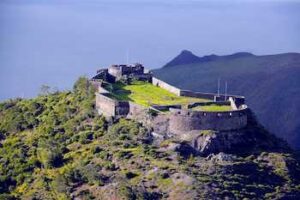
Saint Helena
*On this date in 1502, the island of Saint Helena was discovered. Founded by the Portuguese Armada, it is a remote British overseas territory.
Saint Helena is a volcanic and tropical island in the South Atlantic Ocean, some 1,165 miles west of mainland Africa. Geographically, Angola and Namibia are the closest nations. Between January and May 1673, the Dutch East India Company seized the island, but British reinforcements restored EIC control. The island was fortified with about 230-gun turrets and was instrumental in the Middle Passage.
The British brought an estimated 27,000 slaves from West Africa to the island, in addition to the 3,000,000 they transported to the New World. The importation of slaves was made illegal in 1792. Still, the horrific British conditions of slavery on St Helena were not abolished until May 27, 1839, when the 'Ordinance For the Abolition of Slavery in the Island of St Helena' was enacted.
It is one of the most remote significant islands in the world and was uninhabited when discovered by the Portuguese en route to the Indian subcontinent in 1502. For about four centuries, the island was an important stopover for ships sailing around the African continent from Europe to Asia and back until the opening of the Suez Canal. Saint Helena is the United Kingdom's second-oldest overseas territory after Bermuda. Saint Helena is known as the site of Napoleon's second exile following his final defeat in 1815.
Governor Robert Patton (1802–1807) recommended that the company import workers from China to supplement the rural workforce. Many were allowed to stay, and their descendants integrated into the population. 1810, Chinese laborers began arriving; by 1818, there were 650 in St Helena. An 1814 census recorded 3,507 people on the island. Many laborers were allowed to stay, though the need for their services had reduced by 1836. The island is located 1,210 miles west of the coast of southwestern South Africa and 2,500 miles east of Rio de Janeiro, Brazil.
Rupert's Valley was the holding area for slaves; in 2008, when the road to the airport was being built, over 9,000 skeletal remains of slaves were uncovered in a mass burial area. They were reburied en masse in 2022 without ceremony of any kind. Until 2018, the primary method of reaching Saint Helena was by booking a spot on the RMS St Helena, a cargo and post-delivery vessel that also ferried visitors on a six-day journey from Cape Town, South Africa. Saint Helena measures about ten by five miles and has a population of 4,439 per the 2021 census.